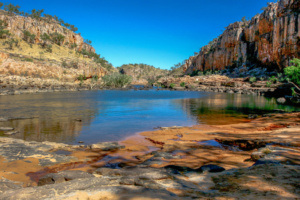The Great Barrier Reef is a wonder that Australia is famous, for. It stretches for 2,300 kilometers along the coast of the country. With its waters, abundant marine life, colorful coral reefs and picturesque islands it’s no wonder why so many people dream of visiting this iconic destination. In this blog post we’ll provide you with all the information you need to know about exploring the Great Barrier Reef. We’ll cover topics such as the time to visit how to get there activities to do and diving spots to explore. Additionally we’ll share some tips on being a tourist and contributing towards preserving this invaluable ecosystem for future generations. Whether you’re a snorkeler, diver or simply someone seeking relaxation on beaches the Great Barrier Reef offers something for everyone.
The Great Barrier Reef is renowned worldwide as one of natures distinct treasures. Here’s a comprehensive guide on discovering this marvel;
Selecting your starting point; Along Queenslands coastline lie numerous embarkation points for embarking on your adventure, in uncovering the wonders of the Great Barrier Reef; these include Cairns, Port Douglas and Airlie Beach.
Determining your mode of transportation; To explore the expanse of the Great Barrier Reef there are options available including boats cruises or alternatively experiencing it from above by opting for a helicopter or seaplane ride.
If you enjoy snorkeling or scuba diving taking a boat tour might be your bet. For those seeking an perspective of the reef opting for a helicopter or seaplane tour is an excellent choice.
First determine the type of tour that suits your preferences. There are options ranging from half day trips, to multi day liveaboard adventures. Some tours focus solely on snorkeling or diving while others offer activities like glass bottom boat tours or visits to islands.
Next select the location within the Great Barrier Reef that you wish to explore. With over 2,900 reefs and 900 islands making up this ecosystem it’s crucial to decide which area captures your interest. Popular reef locations include the Outer Barrier Reef, Low Isles and Green Island.
Consider planning your visit around the weather conditions. While you can explore the Great Barrier Reef throughout the year keep in mind that weather patterns can differ depending on the season. For conditions with waters and dry weather it is recommended to visit between June and October.
Don’t forget to pack items for your trip. Sunscreen, a hat, sunglasses and a rash guard are essentials that will protect you from sun exposure during your time, on the reef.
If you’re planning to go snorkeling or diving it’s an idea to either bring your equipment or rent it from a local provider.
Respecting the reef is crucial when exploring the Great Barrier Reef. Make sure to follow the guidelines provided by your tour operators avoid touching the coral or wildlife and refrain from using chemicals, like sunscreen or insect repellent that can harm the reef.
Take in. Appreciate every moment of your experience exploring the Great Barrier Reef. It’s an opportunity that will leave you with memories whether you’re snorkeling, diving or simply admiring the view from a boat or helicopter. The beauty of this wonder is truly breathtaking.
Consider opting for a guided tour if you’re not familiar with the Great Barrier Reef or if you want to learn more about its ecosystem and marine life. An experienced guide can provide insights into the reef. Point out hidden treasures that might be easily overlooked on your own.
For a perspective try embarking on a night tour offered by operators. This allows you to witness the reef in a light. Night tours are particularly rewarding for observing marine creatures, like turtles and reef sharks.
Make sure to keep an eye out for the events happening at the Great Barrier Reef. From spawning to whale migrations there is always something going on. If you’re keen, on witnessing these events make sure to plan your trip
Don’t forget to bring a camera when visiting the Great Barrier Reef. It’s a haven for photographers. Capturing your experiences underwater is a delight. If you don’t own a camera consider renting one before your trip.
Before booking any activities like scuba diving or snorkeling it’s important to assess your fitness level. Some of these adventures require a level of fitness so be sure to evaluate yourself beforehand. If you have any concerns about your fitness don’t hesitate to discuss them with your tour operator.
If you’re interested in learning about reef conservation and want to contribute consider joining a reef conservation tour offered by operators. These tours provide insights into the challenges faced by the reef. Allow you to participate in conservation activities like coral planting.
For those to seasickness it’s wise to plan. Consider taking medication or wearing bands that can help reduce symptoms while out, at sea. Additionally if you prefer not venturing from shore or would rather explore from above, helicopter or seaplane tours are great alternatives.




